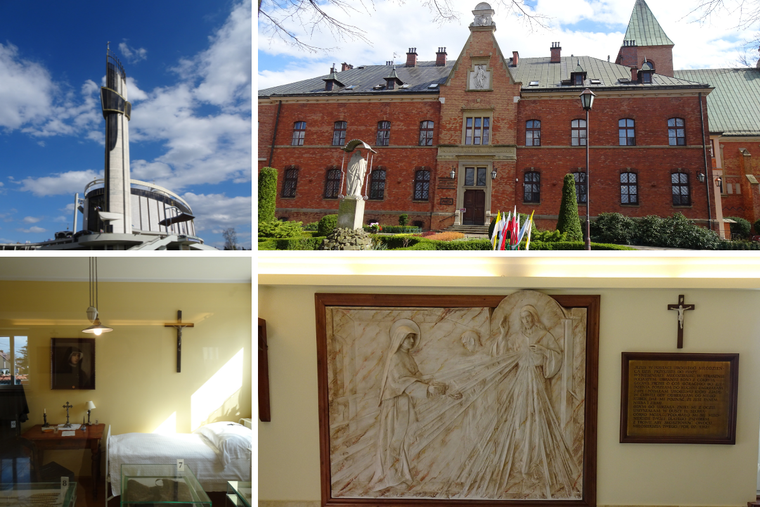- Feb 5, 2002
- 166,616
- 56,251
- Country
- United States
- Faith
- Catholic
- Marital Status
- Married
- Politics
- US-Others
Learn where the ‘Apostle of Mercy’ conversed with Jesus, prayed and lived — and follow in the Mercy Pope’s footsteps, too.
George Weigel fittingly titled his book about Krakow City of Saints. Indeed, throughout the centuries, many saints and blesseds have called Poland’s second-largest city (and the nation’s former capital) home, including Pope St. John Paul II, St. Albert Chmielowski, Casimir Jagiellon and St. Faustina Kowalska. In addition to the adjacent Divine Mercy Sanctuary, pilgrims to Krakow can visit the convent where St. Faustina, one of the great Catholic mystics of the 20th century, lived and is buried.
There are multiple sites in Poland and Lithuania devoted to St. Faustina. Visitors to Lodz (pronounced “woodge”) can see the site in Juliusz Słowacki Park (previously known as Wenecja Park) where, during a dance party in 1924, Jesus appeared to Helena Kowalska (her name prior to becoming a religious) and called her to religious life.
Meanwhile, Faustina’s apparitions of Jesus began in Plock, home to the Shrine of Divine Mercy. Finally, Vilnius, Lithuania (the Polish city of Wilno in the interbellum period), is home to the Divine Mercy Shrine, where visitors can see the iconic image of Divine Mercy painted by Eugeniusz Kazimirowski upon St. Faustina’s extremely detailed instructions. (The 2019 Polish documentary Love and Mercy shows that this image’s features perfectly match up with those of the Shroud of Turin.)
However, it is Krakow that is the world capital of the Divine Mercy devotion. In 1933, Sister Faustina took her final vows in the neo-Gothic convent of the Congregation of the Sisters of Our Lady of Mercy in Krakow’s Łagiewniki (pronounced “wah-gyehv-knee-kee”) district.
Continued below.

 www.ncregister.com
www.ncregister.com
George Weigel fittingly titled his book about Krakow City of Saints. Indeed, throughout the centuries, many saints and blesseds have called Poland’s second-largest city (and the nation’s former capital) home, including Pope St. John Paul II, St. Albert Chmielowski, Casimir Jagiellon and St. Faustina Kowalska. In addition to the adjacent Divine Mercy Sanctuary, pilgrims to Krakow can visit the convent where St. Faustina, one of the great Catholic mystics of the 20th century, lived and is buried.
There are multiple sites in Poland and Lithuania devoted to St. Faustina. Visitors to Lodz (pronounced “woodge”) can see the site in Juliusz Słowacki Park (previously known as Wenecja Park) where, during a dance party in 1924, Jesus appeared to Helena Kowalska (her name prior to becoming a religious) and called her to religious life.
Meanwhile, Faustina’s apparitions of Jesus began in Plock, home to the Shrine of Divine Mercy. Finally, Vilnius, Lithuania (the Polish city of Wilno in the interbellum period), is home to the Divine Mercy Shrine, where visitors can see the iconic image of Divine Mercy painted by Eugeniusz Kazimirowski upon St. Faustina’s extremely detailed instructions. (The 2019 Polish documentary Love and Mercy shows that this image’s features perfectly match up with those of the Shroud of Turin.)
However, it is Krakow that is the world capital of the Divine Mercy devotion. In 1933, Sister Faustina took her final vows in the neo-Gothic convent of the Congregation of the Sisters of Our Lady of Mercy in Krakow’s Łagiewniki (pronounced “wah-gyehv-knee-kee”) district.
Continued below.

Divine Mercy Pilgrimage: A Visit to St. Faustina’s (and John Paul II’s) Krakow
Learn where the ‘Apostle of Mercy’ conversed with Jesus, prayed and lived — and follow in the Mercy Pope’s footsteps, too.
